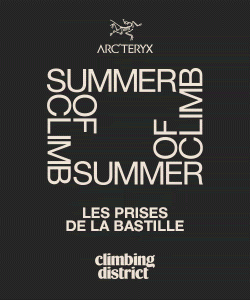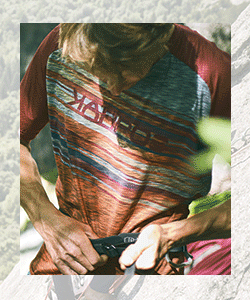Increase Your Onsight Grade By Reading Routes From the Ground

When it comes to route reading for onsight climbing, many climbers don’t. Instead, they simply leap on the rock and see what happens. Yet route reading is a crucial skill that has a powerful and direct effect on performance. Time invested on the ground is energy saved on the route. If you plan your sequence, you will usually climb faster and more fluidly, and eliminate mistakes like swapping hands and feet excessively, clipping from the wrong places, or missing holds and rests. Previewing a line also gives you a psychological edge. By gaining familiarity with the moves, you feel like you’ve already climbed the route.
Route reading from the ground is a skill. Before onsight climbing, many outdoor climbers feel that it doesn’t work for them. But this is simply because they don’t practice. Of course, even if you are able to work out a sequence from the ground, there is no guarantee that you’ll be able to remember it.
It is common to abandon the plan and start free styling in the heat of the battle. Redpoint climbers are good at storing sequences in their heads. But onsight will need to invest extra time here. Of course, there will always be hidden sequences, or times when you can’t tell the size or shape of the holds, but this doesn’t provide an excuse not to bother.

How to read a route
You don’t always need to read a route. Nor is it always helpful to practice it on every route you try. Instead, invest more time as the routes get harder. There is no point spending 10 minutes analyzing your first three warm-ups, especially because you may enjoy them more if you just climb them. Invest your time in the harder routes. Such route reading can be broken down into a series of levels that correspond to difficulty:
Level 0. First two warmups: No route reading
Level 1. Warmups three and four: Identify all holds and plan quick hand sequence
Level 2. Onsight range: For routes in your max onsight range, identify hand sequences, rests, and clips. If you’re trying to practice route reading, repeat this two times, then move to the next step.
Level 3. Max onsight / reach onsight range: For routes at or slightly above your max onsight level, identify hand sequences, rests, clips, and key foot sequences or body positions. Repeat three times.

Level 1: Identify holds and plan hand sequence
The minimum requirement for a quick preview is to identify all the holds and map the hand sequence. This process may only take a minute, yet it could decide whether you are whooping at the anchors or slumping onto the fourth quickdraw. If you do no more than this, it is still worthwhile. Many climbers only bother to view the first half of a route, either because they lack patience or because the top is hard to see. But the top is where you’re carrying a pump and most likely to blow it, so do your best.
Pay particular attention to the smaller and widely positioned holds that may fall outside your on-route field of vision. Don’t tie in until you have scoped the route from all the angles. Viewing from below will reveal undercuts and viewing from the side will reveal sidepulls.
Always check around arêtes and stand far back for a better perspective of the top and to see over the lips of volumes and roofs. Take visual reference points such as marks or features to guide you to a blind hold. Chalk marks may provide clues for hold orientation, but beware false prints! At this stage, distinguish between chalky handholds and boot-rubbered footholds.
Identify holds and visualize the body positions
When planning a hand sequence, mime the moves and imagine yourself gripping each hold—for example, as an undercut or a sidepull. Lean from side to side and visualize the body position. Note key footholds but don’t plan the foot sequence or you may get confused. Plan the hand sequence exactly, and then work out the precise foot sequence as you climb. Remember that poor small holds with chalk may be intermediates.
If a handhold looks poor, but you have to use it, consider whether there is a good foothold in a relevant position. With holds of ambiguous size, the best approach is to rank the options in order of probability. A classic three-way dilemma is whether to cross over, match or go again. A superb tactic for ambiguous sections is to identify key marker holds that lead out from the sequence and to work backwards from there. For example, you know you need to finish with your left hand on a certain hold, so the previous hold must be used with the right hand, and so on.
Level 2: Hand sequence, clips, rests and repeat
As for Level 1 but try to decide on the best clipping holds. A classic mistake is to stretch up and clip from the hold below the draw, or even from two holds below. The optimum clipping hold will usually be level with the draw, or even the next one above. However, always let the size of the hold be the deciding factor. If a lower hold is great then clip from there. Consider clipping from lower down before embarking on a roof or a crux sequence.
Try to spot rests such as stem positions or knee bars (which are often found under volumes) and look out for jugs that you can hook your hand around to rest your grip. Review the whole sequence again, without rushing. Let it all sink in and repeat it a third time if you’re not sure. To get the very most from yourself on a hard onsight, seek this level.
Level 3: Hand and foot sequence, rests and clips during onsight climbing
For advanced climbers the final stage is to attempt to work out some of the key foot sequences, for example on the crux. This stage is not recommended to low-grade climbers as it may create confusion and defeat the purpose of the exercise. Working out a foot sequence requires you to be able to visualize your exact height in relation to the holds.
Be wary of pinning down the foot sequence too precisely; just use it as a guideline and adjust as you climb. It is particularly difficult to work out the exact order in which the foot sequence correlates to the hand sequence (for example: do you reach up or step up first?) so don’t be rigid. On overhanging routes, remember that footholds on the left are nearly always best used with the outside edge of the right foot (and vice versa).
Look out also for moments when a flag could save you from swapping feet twice in a row. For roofs and really steep panels, always consider heel-hooks, toe-hooks and bicycling in order to stop your feet from swinging off. A classic dilemma for steep routes is whether to pick a higher- or lower-positioned foothold to make a reach. The lower foothold will make the reach less strenuous but will increase the risk of foot- pop and/or a difficult release. Go through the whole route three or four times to ensure that it is committed to memory.
Onsight : Feedback
A final tip is to review the route after you’ve climbed it, to see which moves you guessed correctly. This step requires extra discipline. But it will help you further improve your route-reading skills for the future. Regardless of whether you take it to this level, a little more effort with route reading is a smart way to improve.
This article originally appeared in Rock and Ice Issue 203.
The author, Neil Gresham of the UK, is a climbing coach. He has been at the cutting edge of climbing for over two decades. See his website










